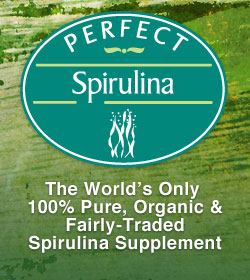 In our last lesson, we learned what Spirulina is and how it is packed with nutrients. In this lesson we move on to the good stuff, what can Spirulina really do for us humans (and any non-humans reading this, we have quite the following in other galaxies).
In our last lesson, we learned what Spirulina is and how it is packed with nutrients. In this lesson we move on to the good stuff, what can Spirulina really do for us humans (and any non-humans reading this, we have quite the following in other galaxies).If I Make Spirulina Part of My Diet, How Will I Feel?
In a word… GREAT! Having a diet rich in all the nutrients and phytonutrients that Spirulina has to offer can provide some great health benefits.
Here is a partial list of the potential health benefits of Spirulina:
- Boost the Immune System*
- Reduce Inflammation*
- Nature's Detoxifier - Cleanse the body*
- Improve Digestion*
- Increase Endurance*
- Reduce Fatigue*
- Boost Energy Levels*
- Help Control Appetite*
- Maintain Healthy Cardiovascular function*
- Support the Liver and Kidneys*
- Provide Benefit to People Who Suffer from Allergies*
Hold The Phone, How Can Spirulina Provide All Those Benefits?
We do not want to make Spirulina out to be some miracle cure all – it is not. The key to keeping the body healthy is eating healthy foods, and you really can not get healthier than Spirulina!
With Spirulina The Sum of The Parts is Greater Than The Whole
Some foods are a great source of protein. Other foods are rich in Vitamin A. Some vegetables are a great way to get your iron. What makes Spirulina very special is that it is very rich in a broad spectrum of nutrients. Spirulina is a complete food, and the body does very well when we provide it with a complete set of nutrients.
When NASA was doing studies to find the perfect space food – something that is nutrient rich, but does not take up much cargo space, they kept coming back to Spirulina. NASA found that 1 kg of Spirulina had the same nutrients found in about 1,000 kgs of "assorted vegetables"!
Chlorophyll Sounds Boring, Let's Call is Plant Blood!
Chlorophyll is what allows plants to transform light into nutrients that the plant can use. This process is called photosynthesis. It is chlorophyll that gives plants and algae their green pigmentation.
Let's be honest, that last paragraph was boring – but what if we just replaced the word Chlorophyll with Plant Blood. Watch how cool that first sentence sounds now – "Plant Blood is what plants use to transform light into nutrients that the plant can use" – much better!
Chlorophyll basically is the blood of plants. Interestingly, Plant Blood is very similar to human blood. Plant Blood has magnesium as the central atom while human blood has iron in the middle - but besides that, they are basically the same chemistry! Numerous studies have shown that chlorophyll can help grow and repair tissues, act as a powerful antioxidant, boost the immune system and help maintain healthy blood function.
Phytonutrients May Be Small, But Their Health Benefits Can Be Huge
Spirulina is filled with important phytonutrients. Just by looking at the color of Spirulina, you can see some of the phytonutrients. The blue-green color of Spirulina comes from its high concentration ofa phytonutrient called phycocyanin.
You probably do not have enough coffee in the house to keep you awake through a whole biology lesson on all the different phytonutrients found in Spirulina, but these nutrients play a key role in the antioxidant and immune boosting benefits of Spirulina.
Spirulina has incredible health benefits on its own but when combined with Chlorella, the benefits are out of this world! Chlorella and Spirulina come together as Perfect Aquatic Greens to create a combination that’s the best thing since peanut butter and jelly! Read more about this nutrient packed super combo here.
Spirulina Sounds Great, What Is The Catch?
Our research showed that Spirulina has incredibly strong potential health benefits. The next step was to look for the negatives with Spirulina – are there side effects? Is there a catch?
We examine this in our next lesson – Potential Side Effects and Dangers of Spirulina








